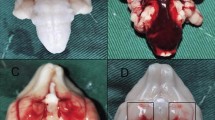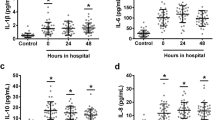Abstract
To investigate the inhibiting effect of β-Aescin on nuclear factor-κB (NF-κB) activation and the expression of tumor necrosis factor-α (TNF-α) protein after traumatic brain injury (TBI) in the rat brain, 62 SD rats were subjected to lateral cortical impact injury caused by a free-falling object and divided randomly into four groups: (1) sham operated (Group A); (2) injured (Group B); (3) β-Aescin treatment (Group C); (4) pyrrolidine dithocarbamate (PDTC) treatment (Group D). β-Aescin was administered in Group C and PDTC treated in Group D immediately after injury. A series of brain samples were obtained directly 6 h, 24 h and 3 d respectively after trauma in four groups. NF-κB activation was examined by Electrophoretic Mobility Shift Assay (EMS A); the levels of TNF-α protein were measured by radio-immunoassay (RIA); the water content of rat brain was measured and pathomorphological observation was carried out. NF-κB activation, the levels of TNF-α protein and the water content of rat brain were significantly increased (P<0.01) following TBI in rats. Compared with Group B, NF-κB activation (P<0.01), the levels of TNF-α protein (P<0.01) and the water content of brain (P<0.05) began to decrease obviously after injury in Groups C and D. β-Aescin could dramatically inhibit NF-κB activation and the expression of TNF-α protein in the rat brain, alleviate rat brain edema, and that could partially be the molecular mechanism by which β-Aescin attenuates traumatic brain edema.
Similar content being viewed by others
References
Baeuerle, P., Baltimore, D., 1996. NF-Kappa B: Ten years after.Cell,87:13–20.
Bakdwin, A.S. Jr, 1996. The NF-κB and IκB proteins: new discoveries and insights.Annu Rev Immunol,14:649–683.
Beg, A.A., Bakdwin, A.S. Jr, 1993. The IκB proteins: multifunctional regulators of Rel/NF-κB transcription factors.GeneDev,9:427–433.
Beg, A.A., Ruben, S.M., Schcinman, R.I., Haskill, S., Rosen, C.A., Baldwin, A.S. Jr, 1992. I kappa B interacts with the nuclear localization sequences of the subunits of NF-κB: a mechanism for cytoplasmic retention.Genes Dev,10:1899–1913.
Connor, T.J., Song, C., Leonard, B.E., Anisman, H., Merali, Z, 1998. An assessment of the effects of central inter-leukin-1 beta, -2, -6, and tumor necrosis factor-alpha administration on some behavioural neurochemical, endocrine and immune paramenters in the rat.Neuroscience,84:923–933.
Fransserr, C., Defraigne, J.O., Detry, O, 1995. Antioxidant defense and free radical production in a rabbit model of kidney ischemia-reperfusion.Transplant-Proc,27:2880–2883.
Hiai, S., Yokoyama, H., Oura, H, 1981. Effect of Aescin of adreno-corticotropin and corticosterone levels in rat plasma.Chen Pharm Bull,29:490.
Ichikawa, K., DeGroot, L.J., Refetoff, S.H., Nuorwitz, A.L., Pollak, E.R, 1986. Nuclear thyroid hormone receptors in cultured human fibrobasts: improved method of isolation, partial characterization, and interaction with chromation.Metabolism,35:861–868.
Korner, M., Rattner, A., Mauxion, F., Sen, R., Citri, Y, 1989. A brain specific transcription activator.Neuron,3:563–572.
Lee, J.I., Burekart, G.J, 1988. Nuclear factor-kappa B: important transcription factor and therapeatic target.J Clin Pharmacol,38:981–993.
Lü, H.S, 1993. β-Aescin and appliation in clinic.J Tongji Medical University,22(3):218–220 (in Chinese).
Nanaka, M., Chen, X.H., Pierce, J.E., Leoni, M.J., Melntosk, T.K., Wolf, J.A., Smith, D.H, 1999. Prolonged activation of NF-κB following traumatic brain injury in rats.J Neurotrauma,16:1023–1034.
Stover, J.F., Schoning, B., Sakowitz, O.W., Woiciechowsky, C., Unterberg, A.W., 2001. Effects of tacrolimus on hemispheric water content and cerebrospinal fluid levels of glutamate, hypoxanthine, interleukin-6, and tumor necrosis actor-alpha following controlled cortical impact injury in rats.J Neurosurg,94:782–787.
Sullivan, P.G., Bruce-Keller, A.J., Rabchevsky, A.G., Chris-lakos, S.., Clair, D.K., Mattson, M.P., Scheff, S.W, 1999. Exacerbation of damage and altered NF-κB activation in mice lacking tumor necrosis factor receptors after traumatic brain injury.J Neurosci,19:6248–3260.
Suzumura, A., Ito, A., Yoshikowa, M., Sawada, M, 1999. Ibudilast suppresses TNF alpha production by glial cells functioning mainly as type III phosphodiesterast inhibition in the CNS.Brain Res,837:203–212.
Author information
Authors and Affiliations
Corresponding author
Additional information
Project (No. 2003B013) supported by the Health Department of Hangzhou, China
Rights and permissions
About this article
Cite this article
Xiao, Gm., Wei, J. Effects of β-Aescin on the expression of nuclear factor-κB and tumor necrosis factor-α after traumatic brain injury in rats. J Zheijang Univ Sci B 6, 28–32 (2005). https://doi.org/10.1631/jzus.2005.B0028
Received:
Revised:
Published:
Issue Date:
DOI: https://doi.org/10.1631/jzus.2005.B0028




